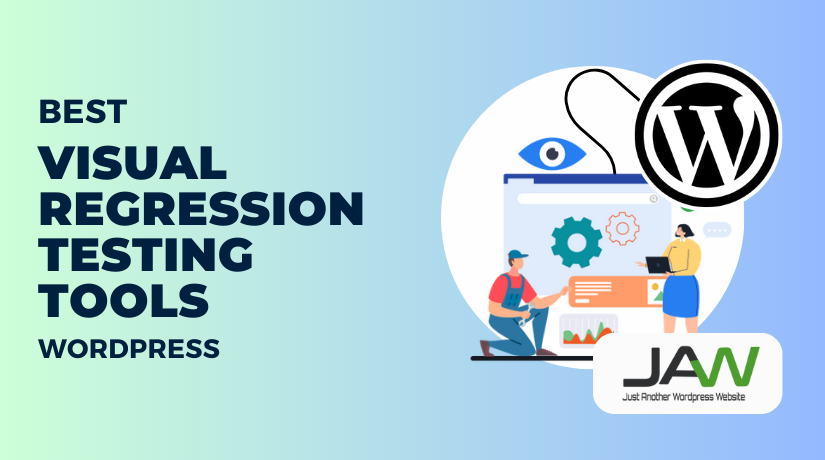
Table of Contents
- Why Does WordPress Need Visual Regression Testing?
- How Visual Regression Testing Operates
- Best Visual Regression Testing Tools for WordPress
- How to Choose the Best Visual Regression Testing Tool for Your WordPress Site
- How to Set Up Visual Regression Testing in WordPress (Step-by-Step Guide)
- Common Challenges in Visual Regression Testing and How to Overcome Them
- Conclusion
Worldwide, millions of websites are powered by WordPress. Regular updates improve security and performance. However, updates can cause unexpected design changes.
Visual regression testing tools aid in identifying undesired layout changes. Versions of websites before and after modifications are compared. This guarantees a consistent experience for the user.
Manual testing is labor-intensive and error-prone. Tools for visual regression testing automate this procedure. These tools assist website owners and developers in maintaining the correctness of their designs.
We’ll look at visual regression testing with WordPress in this post. We’ll also examine the top tools on the market.
What is Visual Regression Testing?
Visual regression testing looks for unforeseen design changes on websites. Screenshots are taken both before to and following changes. The program then looks for discrepancies by comparing them.
These differences may include:
- Layout shifts – Elements moving out of place.
- Color changes – Incorrect colors appearing after an update.
- Missing elements – Buttons, images, or text disappearing.
- Font issues – Text looking different from the original version.
Conventional testing emphasizes functionality. Testing for visual regression guarantees that the website appears as intended. This keeps unforeseen design problems following upgrades at bay.
Why Does WordPress Need Visual Regression Testing?
WordPress sites update frequently. Core updates, theme updates, and plugin updates are common. These changes can affect the site’s appearance.
For example, a plugin update may break the site layout. A theme update might change font styles. These issues can harm user experience and brand identity.
Using visual regression testing tools helps catch these problems early. This prevents broken designs from reaching users.
Visual Regression Testing Advantages:
✅ Saves time – No need to manually check every page.
✅ Ensures consistency – Keeps design elements stable across updates.
✅ Reduces errors – Catches problems before they go live.
✅ Improves user experience – Visitors see a well-designed website.
For WordPress site owners, WordPress Support with visual regression testing is crucial. It guarantees that changes won’t impact the look of websites. This method may be automated to simplify site upkeep.
How Visual Regression Testing Operates
A website’s design modifications can be found with the use of visual regression testing. It compares versions in a straightforward manner.
Step-by-Step Process:
- Take a baseline screenshot – The tool captures the original design.
- Make changes – Update WordPress, themes, or plugins.
- Capture a new screenshot – The tool takes another image.
- Compare screenshots – Differences between old and new versions are highlighted.
- Approve or reject changes – The user decides if the changes are correct.
Types of Comparison Methods:
- Pixel-by-pixel comparison – Detects even the smallest design changes.
- DOM-based comparison – Focuses on changes in website structure.
- AI-powered comparison – Filters out minor shifts and finds real issues.
Visual testing that is automated is quicker than human inspections. Before they go online, it assists developers in identifying issues.
Best Visual Regression Testing Tools for WordPress
Automating visual regression testing in WordPress is made possible by a number of technologies. While some provide sophisticated features, others are free.
Open-Source and Free Tools
BackstopJS
BackstopJS is a well-known open-source program. It is compatible with Chrome and takes screenshots of websites. Before deploying changes, developers test them with it.
✅ Open-source and free.
✅ Supports different screen sizes.
✅ Runs automated tests in the browser.
Wraith
Wraith was created by the BBC for visual testing. It helps compare website changes over time.
✅ Takes pictures of the before and after.
✅ Works well for static websites.
✅ Uses simple configuration settings.
Reg-Suit
Another free tool for visual regression detection is Reg-Suit. It works nicely with CI/CD processes.
✅ Best for developers using automated pipelines.
✅ Works with GitHub and other repositories.
✅ Supports different image comparison methods.
Premium & Cloud-Based Tools
Applitools
Applitools detects visual differences using AI. It functions on a variety of systems, including WordPress.
✅ AI-powered for accurate results.
✅ Supports cloud-based testing.
✅ Reduces false positives in comparisons.
Percy by BrowserStack
Percy gives teams access to visual tools for regression testing. Screenshots of websites are taken and compared by it.
✅ Integrates with GitHub, Bitbucket, and CI/CD pipelines.
✅ Cloud-based, no local setup required.
✅ Offers detailed test reports.
Diffy
Diffy was created specifically for visual regression testing in WordPress. It evaluates website designs both before and after modifications.
✅ Allows for WordPress upgrades.
✅ Simple enough for novices to utilise.
✅ Runs tests in different environments.
LambdaTest
LambdaTest facilitates the testing of website layouts across many browsers. It comes with cross-browser testing tools for visual regression testing.
✅ 3000+ browsers are supported.
✅ Cloud-based and easy to access.
✅ Works well with automation tools.
Visual Regression Tests (WordPress Plugin)
The purpose of this WordPress plugin is to test visual modifications. It is easily integrated into the dashboard of WordPress.
✅ No coding required.
✅ Easy setup for WordPress users
✅ Allows before-and-after comparison of pages.
How to Choose the Best Visual Regression Testing Tool for Your WordPress Site
Your demands will determine which visual regression testing tool is best for you. While some tools are basic, others have sophisticated functionality.
Factors to Consider:
✅ Ease of use – Some tools need coding skills; others do not.
✅ Integration – Check if it works with WordPress or CI/CD pipelines.
✅ Accuracy – Avoid tools that detect false issues.
✅ Automation – Select tools with functionality for scheduled testing.
✅ Cost – Free tools are great, but premium tools offer more features.
Top Resources for Various Users:
👨💻 Beginners – Use WordPress plugins like “Visual Regression Tests.”
💼 Developers – Choose open-source tools like BackstopJS.
🏢 Large Businesses – Use AI-powered tools like Applitools.
Your choice depends on your website size and testing needs.
How to Set Up Visual Regression Testing in WordPress (Step-by-Step Guide)
Setting up visual regression tests is easy with the right tools. Follow these steps to get started.
Step-by-Step Guide:
1️⃣ Select a tool – Select a cloud-based, open-source, or plugin tool.
2️⃣ Install and configure – Configure the tool according to your requirements.
3️⃣ Capture a baseline screenshot – This picture will serve as your point of reference.
4️⃣ Make website changes –Update plugins, WordPress, or themes.
5️⃣ Run a test – A fresh screenshot is taken by the tool.
6️⃣ Compare results – Examine how the new and old versions differ.
7️⃣ Approve or reject changes—Preserve or correct modifications found.
Best Practices for Effective Testing:
✔️ Prior to and following changes, run tests.
✔️ Test different devices and screen sizes.
✔️ Schedule automated tests for regular monitoring.
✔️ Exclude dynamic elements like sliders and ads.
By using visual regression testing tools, design flaws are avoided before consumers see them. Time is saved, and a seamless user experience is guaranteed.
Common Challenges in Visual Regression Testing and How to Overcome Them
Design stability is increased by visual regression testing. Results, however, can be impacted by certain difficulties. These are typical issues and solutions.
False Positives
False positives happen when minor changes trigger alerts. Small shifts in pixels can be detected as issues.
✅ Solution: Use AI-powered tools like Applitools to reduce false alerts.
✅ Solution: Adjust sensitivity settings in your testing tool.
Dynamic Content
Elements like sliders, pop-ups, and ads can change often. These cause unnecessary test failures.
✅ Solution: Exclude dynamic content areas from the test.
✅ Solution: Use tools that support ignoring animations and moving elements.
Performance Issues
Some tools take longer to run tests, slowing workflows.
✅ Solution: Choose cloud-based tools for faster processing.
✅ Solution: Run tests only on important pages to save time.
Cross-Browser Differences
Websites may look different in various browsers. Testing all browsers can be difficult.
✅ Solution: Use cross-browser testing tools like LambdaTest.
✅ Solution: Focus on the most commonly used browsers for your users.
These solutions help improve visual regression tests and get better results.
Conclusion
WordPress websites require visual regression testing. After upgrades, it aids in identifying design modifications. This guarantees a consistent experience for the user.
✅ Automated tools save time and improve accuracy.
✅ Different tools suit different users, from beginners to developers.
✅ Following best practices helps prevent false positives and errors.
The design of your website is protected when you use visual regression testing tools. It guarantees that upgrades won’t result in unforeseen problems.

